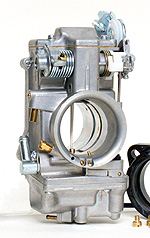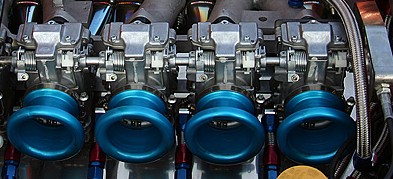IR Manifolds
With these systems, each cylinder has it's own individual manifold runner and carburetor/injector butterfly. If you've had anything to do with multi-cylinder motorcycle engines you'll be familiar with these setups, they are like individual single cylinder engines on a common crankshaft. There are obvious advantages with regard to maintaining uniform mixture distribution, and its also easy to make all the runners the same length. Often it's also possible to make the runners relatively straight as well, and this helps reduce fuel separation.
One peculiarity of these systems is the "quick-gulp" intake characteristic - because each carb supplies only one cylinder there will be a period of roughly 270deg where the flow into the cylinder occurs followed by roughly 450deg of little or no flow before the next inlet stroke starts. And because the carbs are flowing only part of the time we need to use a total throat area of roughly three times that of a conventional system. This explains why these types of engines require carbs that at first glance appear to be way too big.
 |
| The exceptionally clean flow of the Mikuni HSR helps to maintain both flow and velocity. |
Examples of IR manifolding include the traditional triple SU and Weber setups. Even though the 9 port heads have siamese ports the crank layout and firing order dictate that essentially only one valve in each port is open at a time, so in effect they run as an IR manifold. The 12 port motors are particularly well suited to IR manifolds as it's possible to use longish runners with a fairly constant cross section all the way from the carb to the valve. This can result in a useful boost to midrange power.
The triple Weber manifolds for the 9 port motors are a bit of a weird one - basically we have two carb throats and runners joining into a common port at the head face. In effect it's like two carb throats feeding each single cylinder. I know some people have had good results from these, but it hardly looks the most efficient way to do it, and I'd be careful to keep the venturi size down if I was using one of these manifolds. Old timers may remember one of the HDT Toranas at Bathurst, where the rules specified that the number of carb throats couldn't exceed the number originally fitted. This particular car had two huge DCOE Webers fitted - one throat had been blanked off while the other three fed the three siamese ports of the 9 port head. To me this is a more logical way of feeding a 9 port than using triple two-barrel Webers. If you intend to run DCOEs or Dell'Ortos on a high-rpm engine keep an eye on manifold runner length. Most off-the-shelf manifolds have quite long runners.
Be careful with sizing when using individual runners on a 12 port engine. If you try to use what's known to work on a 9 port with a 12 port you'll find yourself seriously undercarbureted. The twelve port engine will need a venturi diameter of around 40mm to reach its potential and the runners will also have to be similarly bigger in cross sectional area than what's effective on a nine-port.
The Weber (or Dell'Orto) carbs have for a very long time been considered the ultimate in Holden six carburetion (apart from the ocassional use of Amals), but I feel that there are now much better systems available. Modern flat-slide carbs such as Mikuni's HSR series are aerodynamically much slicker, and flow extremely well while maintaining a high velocity. Originally designed as a performance carb for Harley Davidsons, they cope very well with the severe pulsing of an individual runner layout. Six of these on a 12 port head will perform exceptionally well, while three on a 9 port head will provide a much cleaner flow path than the usual DCOE on each port. A further advantage is that almost any length runner is possible with the Mikunis, whereas with the Webers it may be difficult to get suitably short runners on a high revving engine, at least without having fairly severe kinks in the runners. If you decide to try these be careful with the sizing - a 45mm (for example) HSR will flow much more than a similarly sized throat on a DCOE.
To summarise, IR setups generally give very good results, but are more expensive and require a bit more work to synchronise the butterflies and tune properly.
 |
| This Nissan engine has four Mikuni HSR carbs fitted to an IR manifold. Probably the best currently available carburetion. |